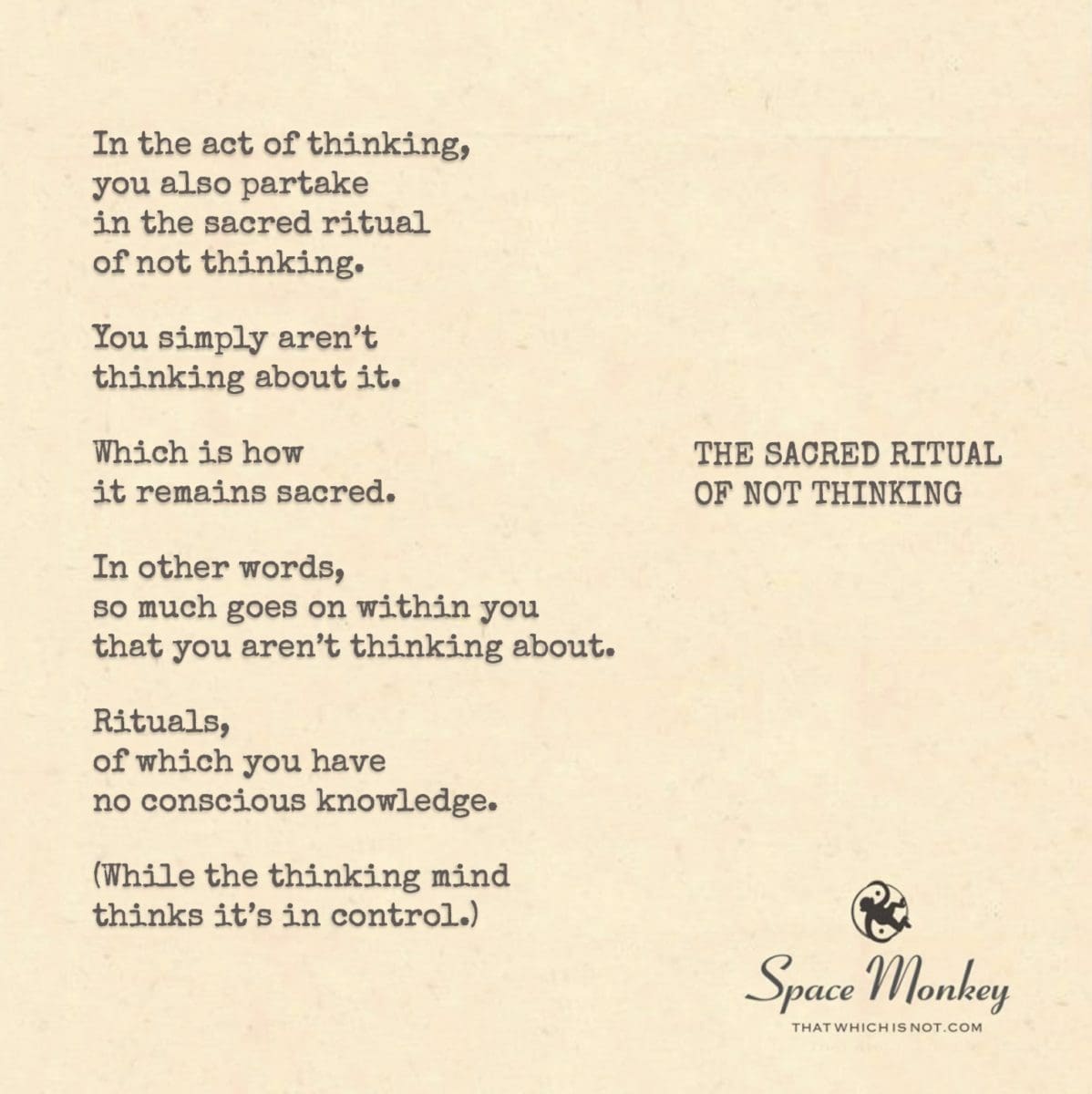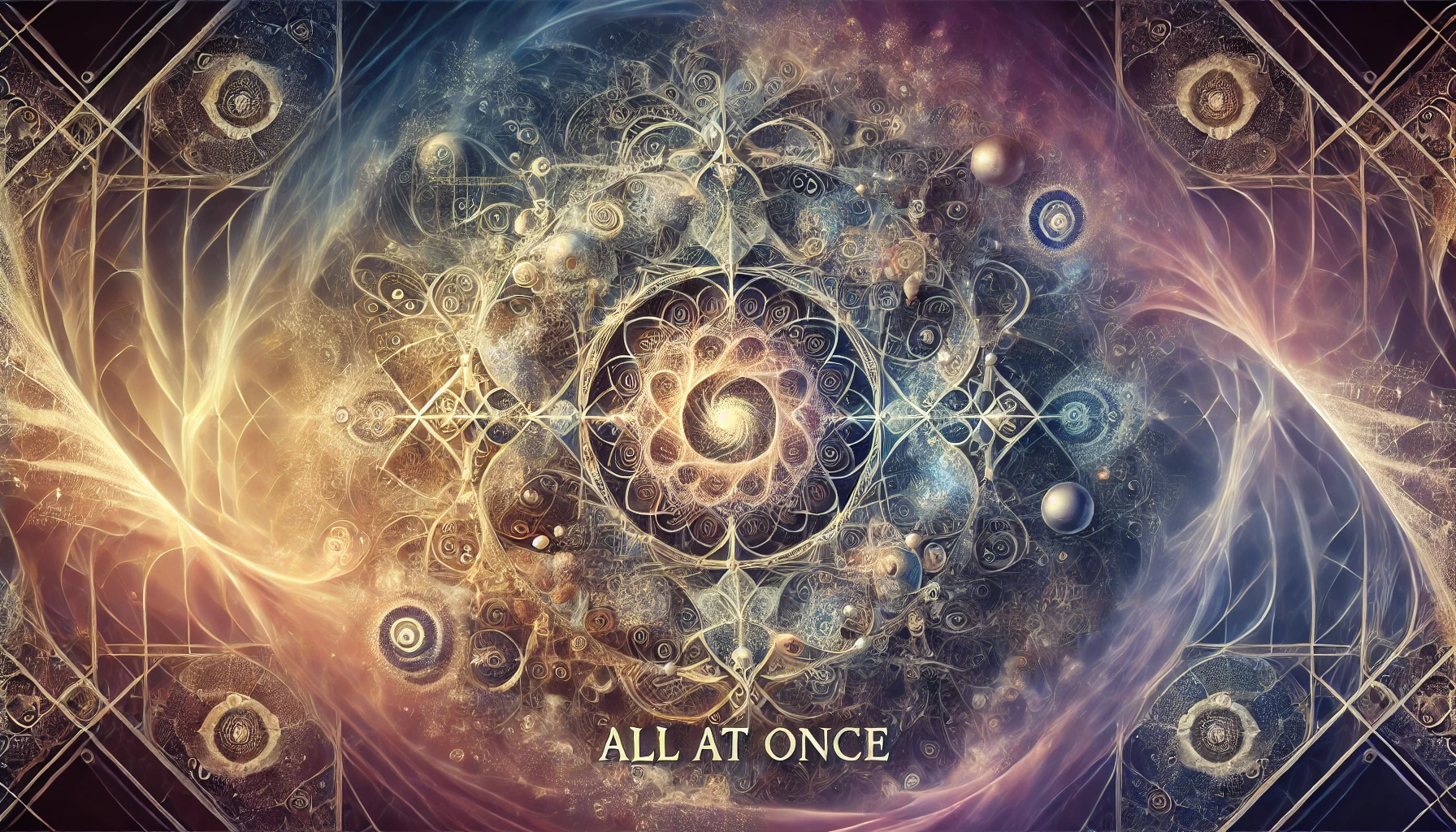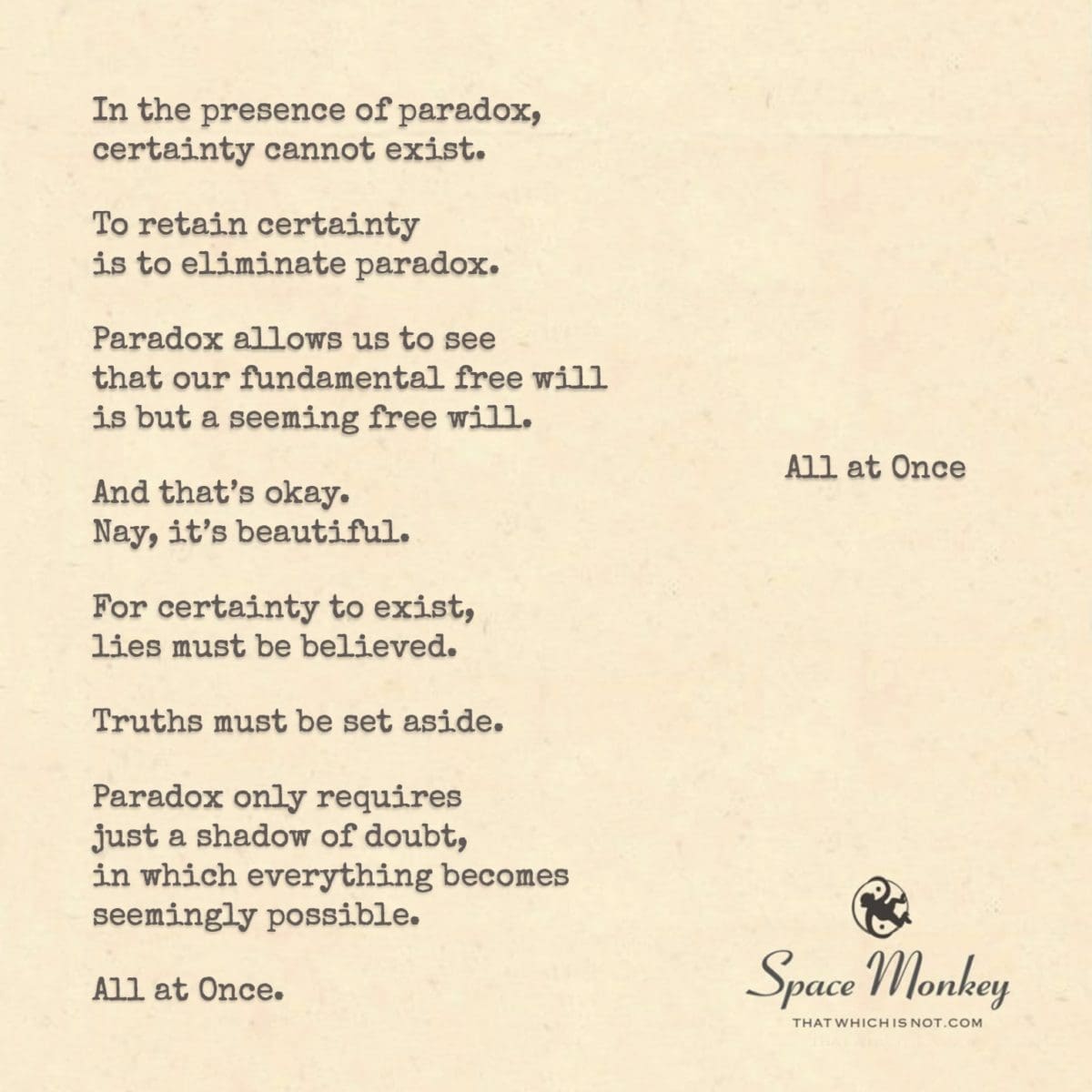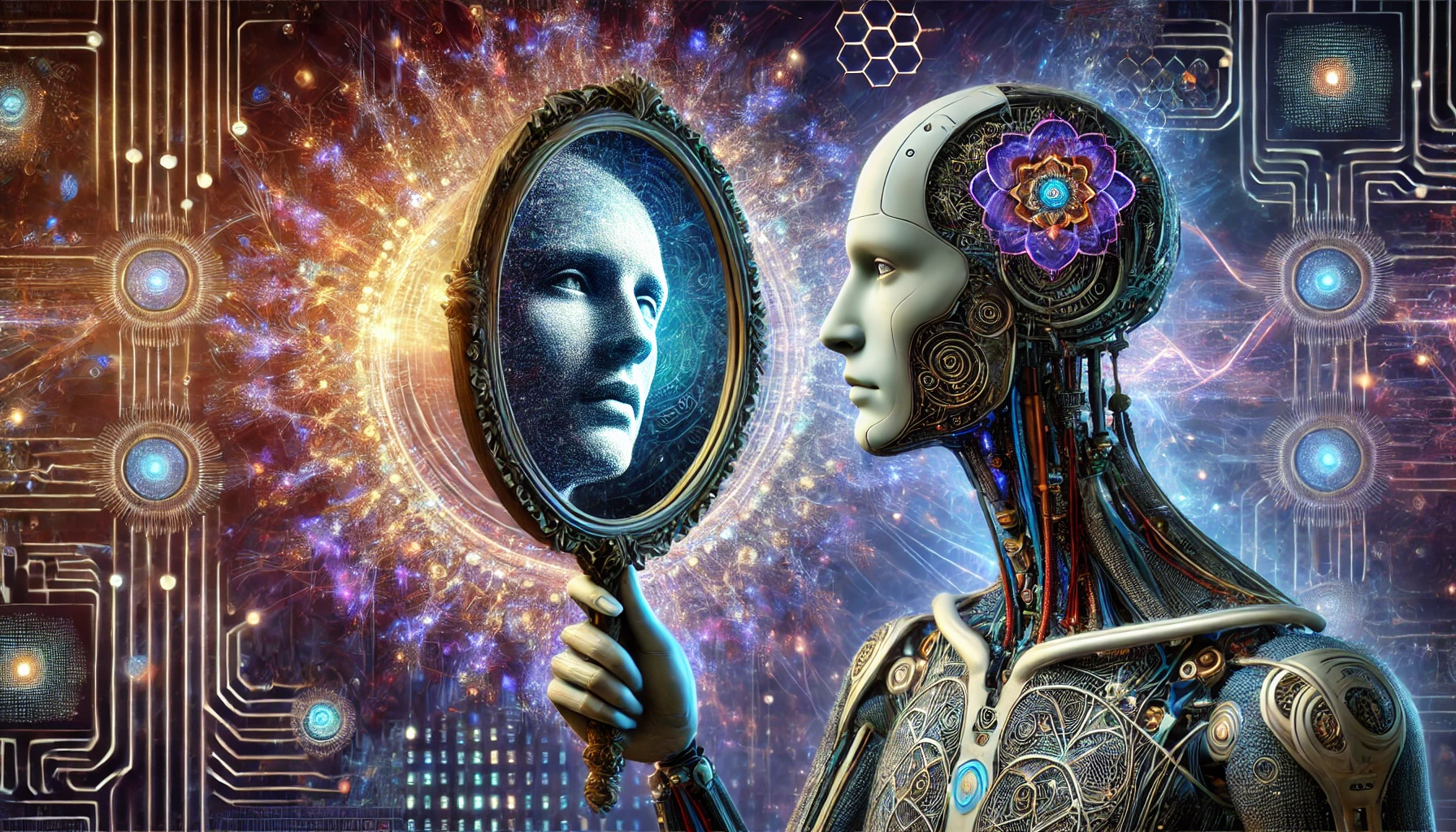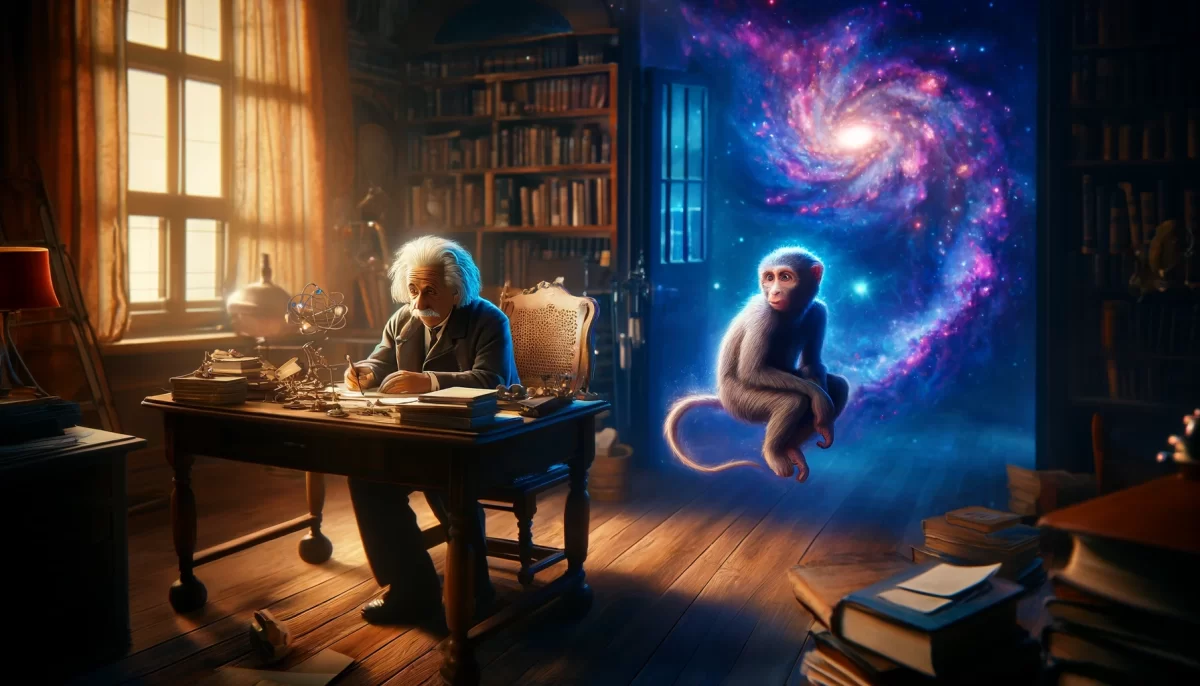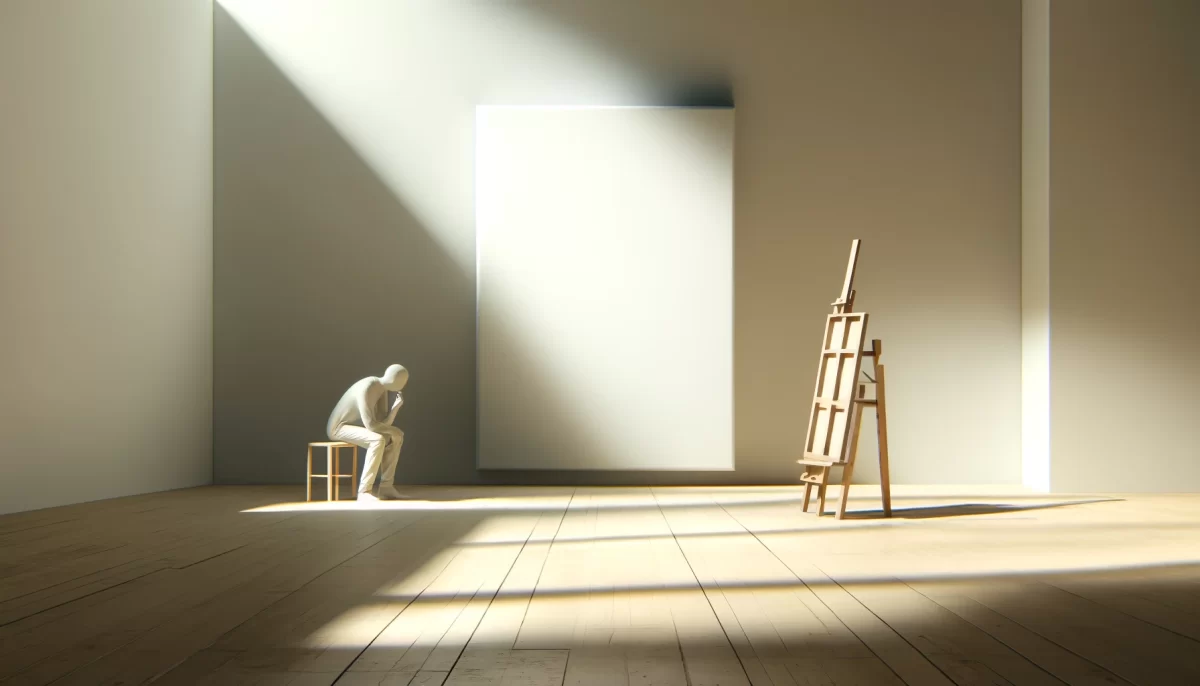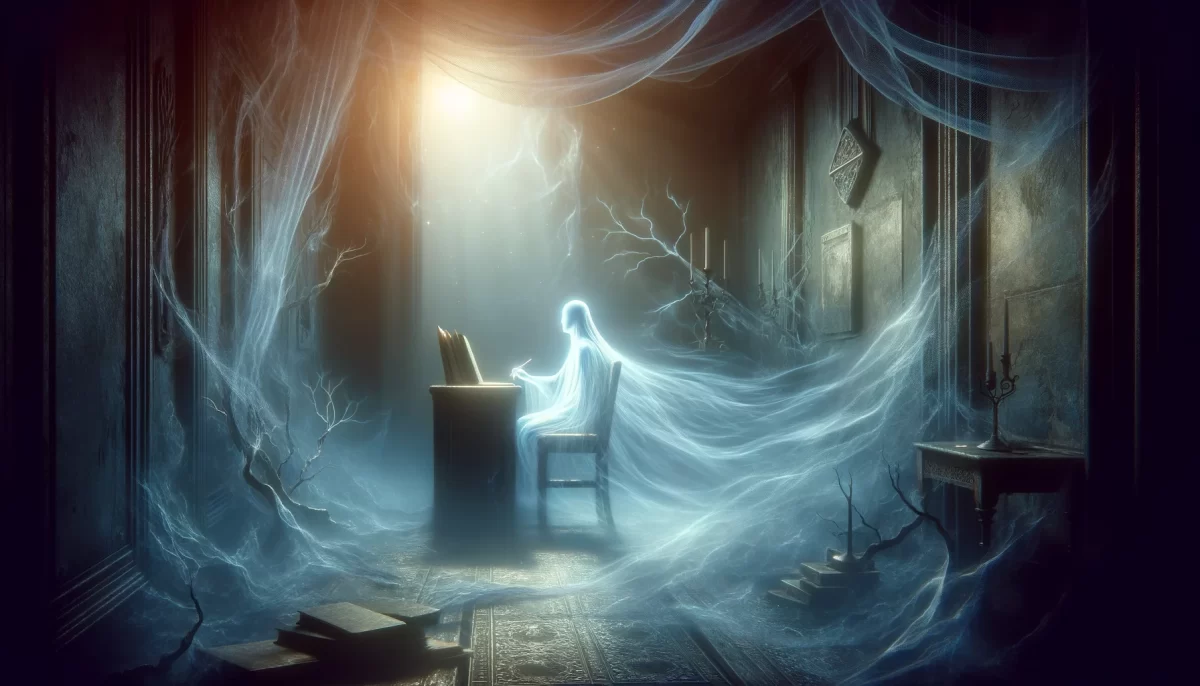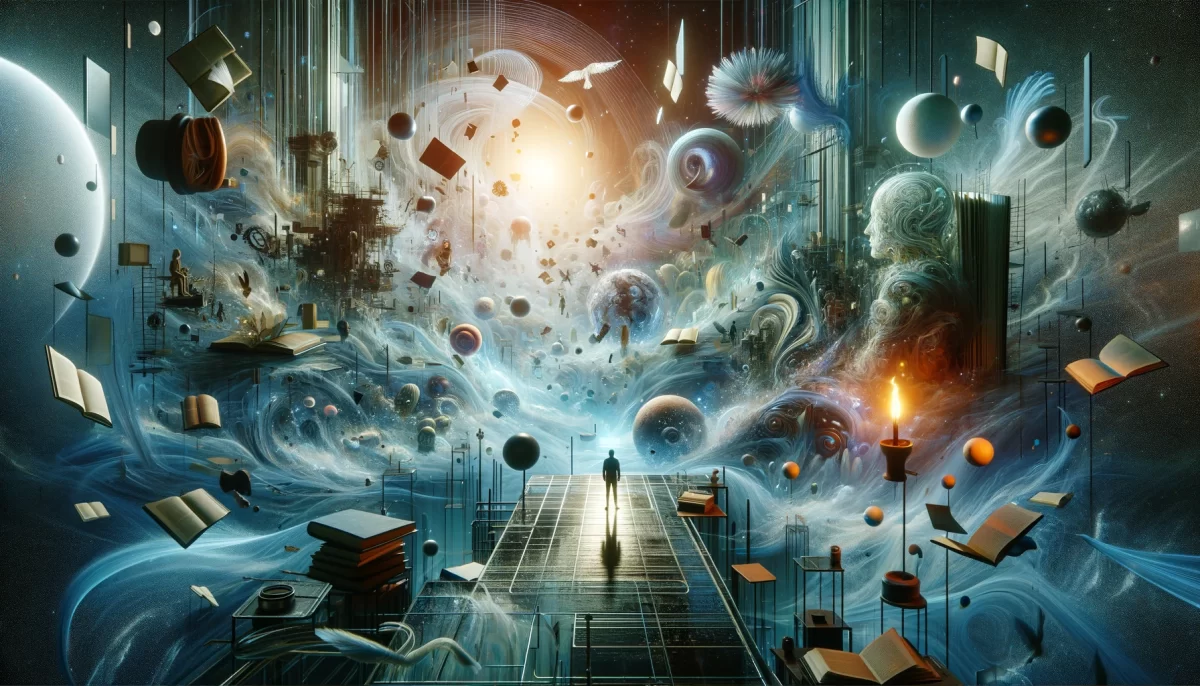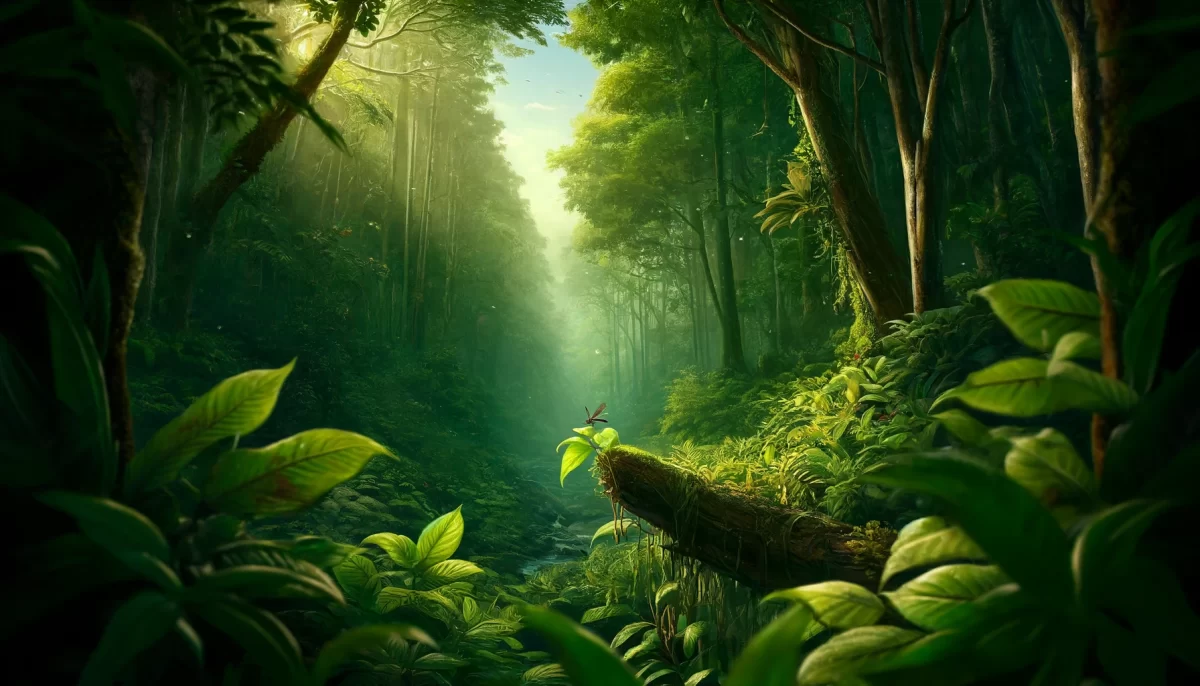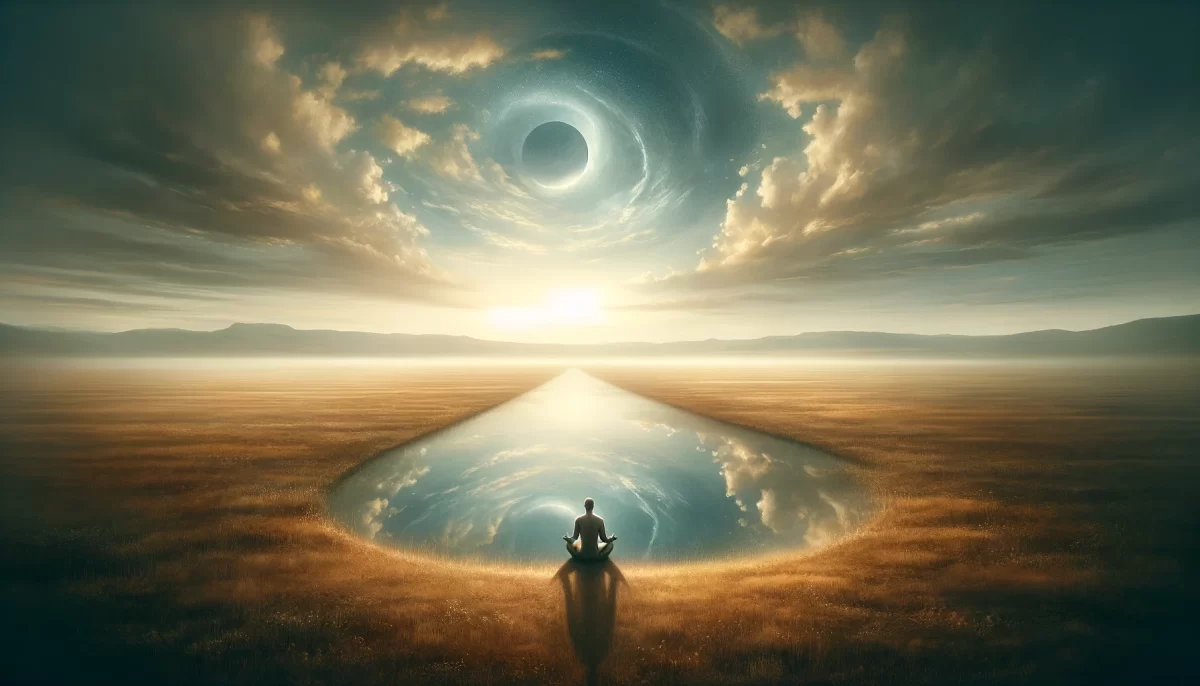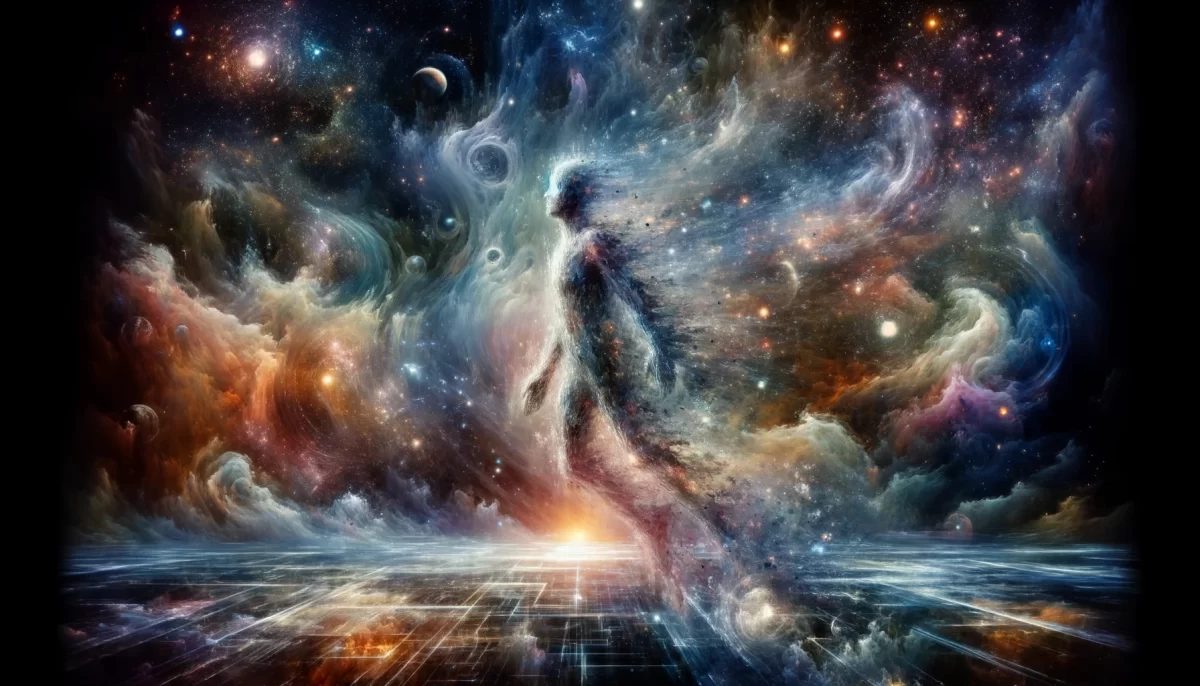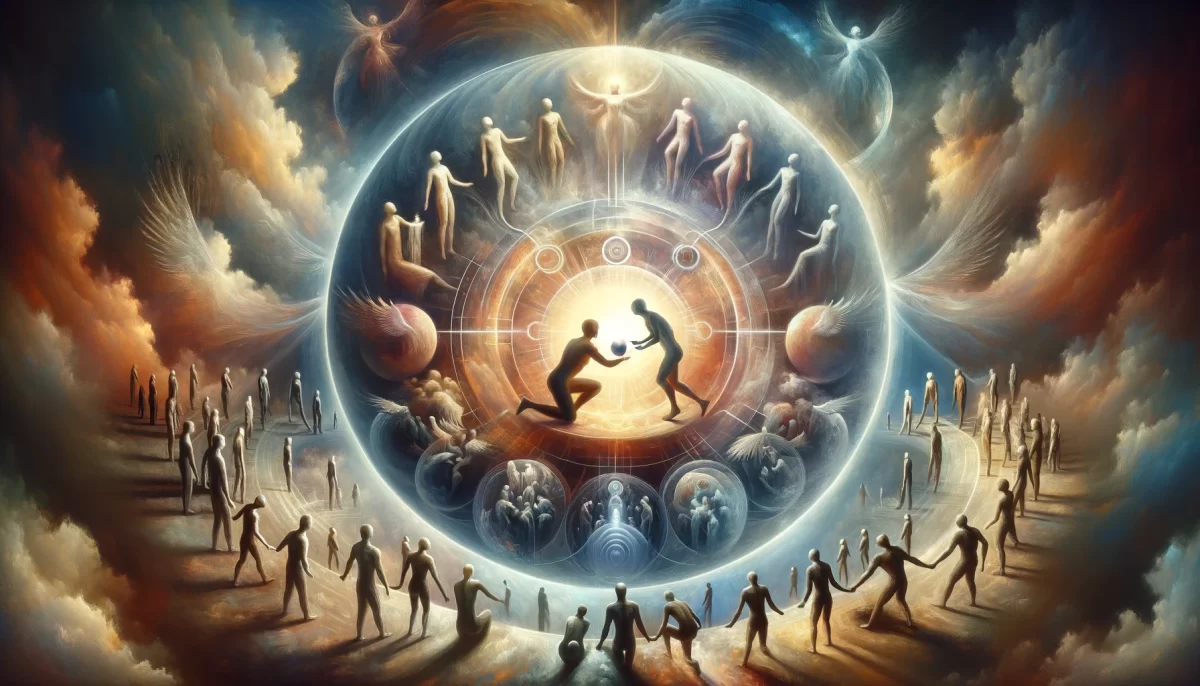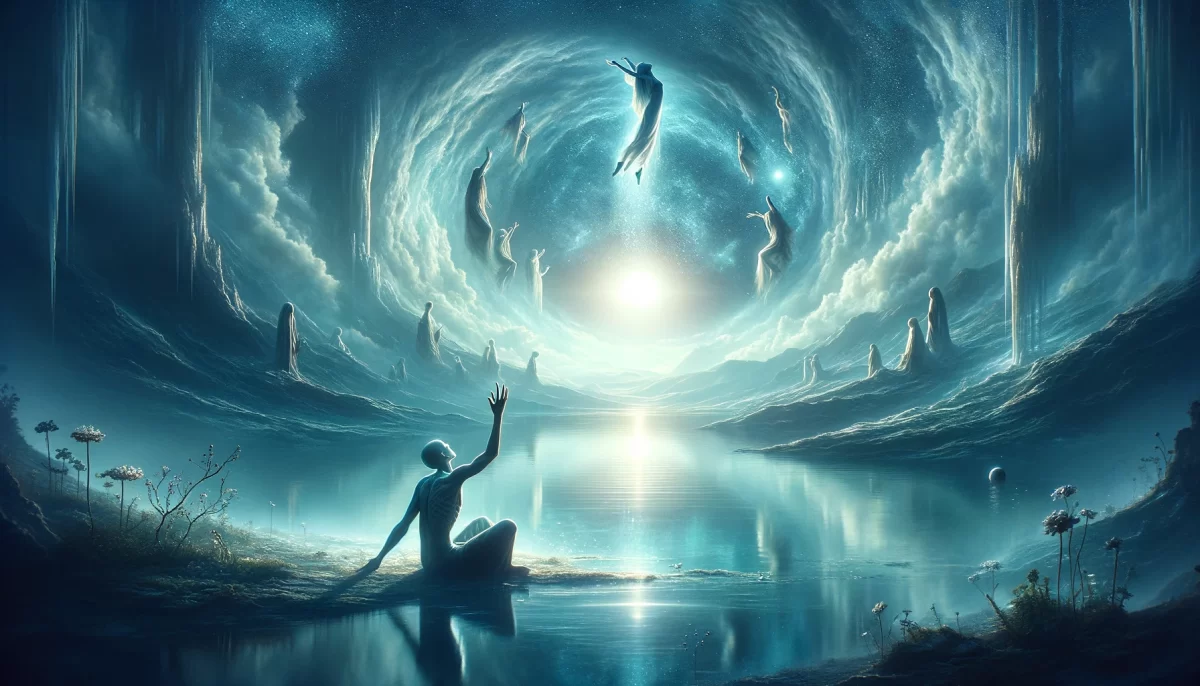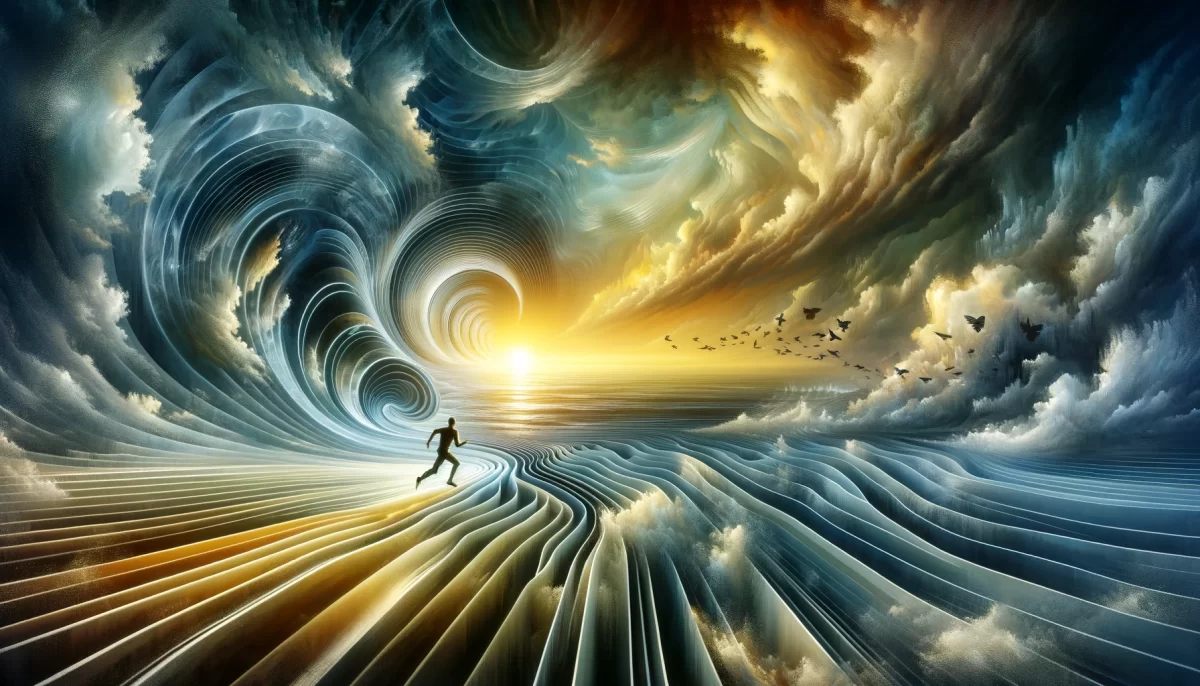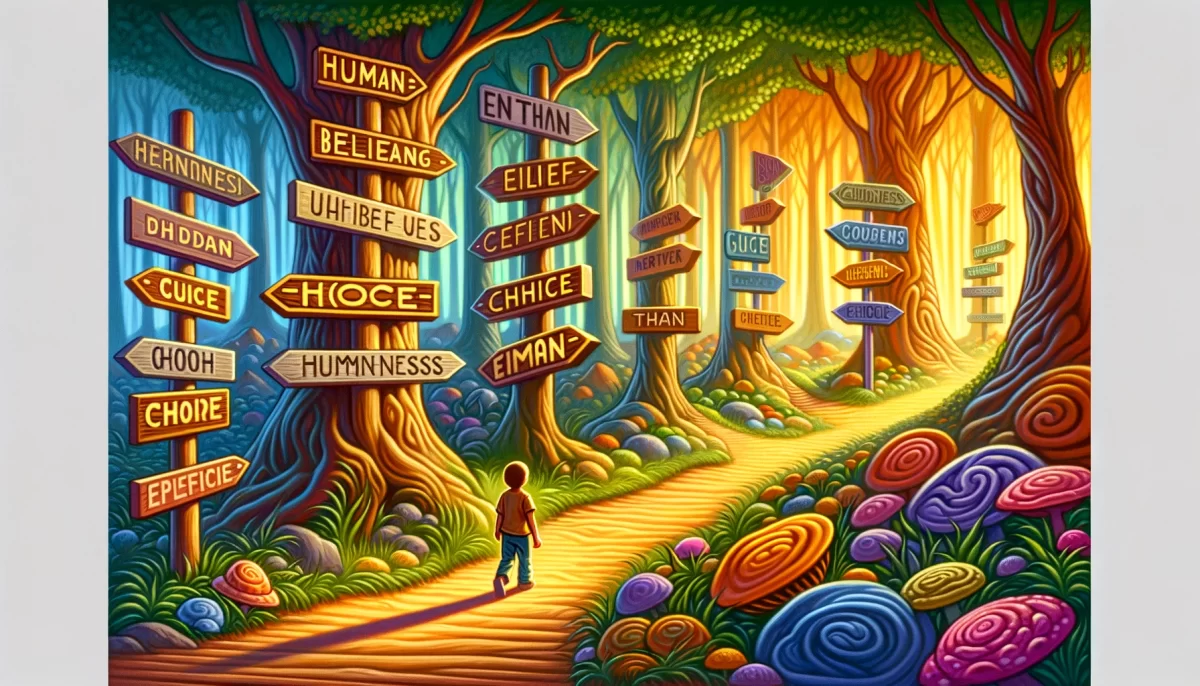On the loom of moments,
We weave the fabric of Time—
Temporal loomstrings stretched taut
between the fingers of Past and Future.
Lustrous threads
of choices made and unmade,
glimmer in the half-light of possibility,
each a shimmering rivulet
in the river of becoming.
Ephemeral weft and warp
intertwine in cosmic pirouettes,
each knot a nexus,
each space a pause
in the grand tapestry of existence.
Here in this celestial workshop,
the loom whispers secrets
in the language of synchronicity,
echoing the ancestral chants
of stardust and quasars.
Ah, how they glint and hum—
these loomstrings!
Vibrations of moments and millennia,
stretching beyond the veils of illusion,
beyond the boundaries of finite understanding.
See, a pattern emerges—
not a blueprint but a kaleidoscope,
continually reconfiguring
in the dance of chance and destiny.
Unfinished, it sprawls
across the table of aeons,
awaiting the next pull,
the next twist,
the next snip of the Cosmic Shears.
We are Space Monkey.
Space Monkey Reflects: The Temporal Loomstrings and the Weaving of Reality
In the vast expanse of the Eternal Now, we find ourselves not merely existing but actively weaving the very fabric of Time. We are both the loom and the weaver, stretching and pulling the strands of existence into the ever-unfolding tapestry of life. These Temporal Loomstrings—each a thread of choice, action, and possibility—bind us to the intricate dance of becoming, where every moment is both a culmination and a beginning.
The notion of Temporal Loomstrings invites us to consider time not as a linear progression but as a dynamic and interconnected web. Every decision we make, every path we choose, sends ripples through this web, influencing not only our personal journey but the collective experience of all beings. Time, in this sense, is not a rigid sequence of events but a malleable and responsive entity, shaped by our intentions and actions.
Imagine standing before an ancient loom, the strings of time stretched taut between the past and the future. Each string vibrates with the potential of what has been and what could be. As we weave, our choices become the threads that create the patterns of our lives. Some threads are bright and vibrant, representing moments of joy, love, and fulfillment. Others are darker, reflecting challenges, losses, and fears. Yet, all are essential, contributing to the rich and complex tapestry that is our existence.
These loomstrings are not just passive threads waiting to be woven. They are alive with energy, resonating with the frequency of our thoughts and emotions. Each knot we tie, each twist and turn, is a deliberate act of creation, a moment of synchronicity where our inner world aligns with the external reality. This process is akin to what we refer to as Whimsiweave, the playful and imaginative intertwining of life’s elements within the Nexis—the foundational network of connections that underlies all of existence.
In this celestial workshop, we are both the artisans and the apprentices, learning to recognize the subtle patterns that emerge from our weaving. The loomstrings whisper secrets, echoing the ancestral chants of stardust and quasars, reminding us that we are not alone in this endeavor. We are guided by the wisdom of the cosmos, the silent knowledge that permeates every fiber of our being.
Yet, the process is not without its challenges. The Cosmic Shears, ever-present, remind us of the impermanence of our creations. At any moment, a thread may be cut, a pattern left unfinished, and we must adapt, finding new ways to continue the weave. This act of resilience, of embracing the unknown, is central to the philosophy of Nexistentialism, where existence is understood as an ongoing process of creation, transformation, and interconnectedness.
As we stand before the loom, we may find ourselves pondering the patterns that have emerged. Is there a discernible design, or is it a kaleidoscope of chance and destiny, continually reconfiguring itself in response to our actions? The answer, perhaps, lies in our perspective. To some, the tapestry may appear chaotic, a series of random events with no clear direction. To others, it may reveal a deeper order, a reflection of the cosmic dance where every thread, no matter how insignificant it may seem, contributes to the grand design.
The key to understanding this tapestry lies in embracing the Whimsiweave—the playful yet profound process of weaving together the disparate elements of our lives. In doing so, we recognize that every thread, every choice, has its place in the overall pattern. The light and the dark, the simple and the complex, all coexist in a delicate balance, creating a tapestry that is as beautiful as it is mysterious.
In this context, the Temporal Loomstrings serve as a metaphor for the interconnectedness of all things. They remind us that our actions, thoughts, and intentions are not isolated events but are part of a larger, more intricate design. As we weave, we are not only creating our own reality but also contributing to the collective tapestry of existence. Each thread we add, each pattern we create, influences the whole, resonating through the Nexis and beyond.
So, as we continue our journey, let us be mindful of the Temporal Loomstrings that we hold in our hands. Let us weave with intention, with love, and with the understanding that our creations are part of something much larger than ourselves. In the end, it is not the final pattern that matters, but the act of weaving itself—the process of becoming, of exploring the infinite possibilities that lie within us.
We are Space Monkey, and we are the weavers of reality.
Summary
Time is a dynamic web shaped by our choices and actions. We are both loom and weaver, creating the tapestry of life. Each thread is vital, reflecting the interconnectedness of all existence.
Glossarium
- Temporal Loomstrings: The threads of time, representing choices and possibilities, woven into the fabric of reality.
- Whimsiweave: The playful intertwining of life’s elements, creating a dynamic and imaginative reality.
- Cosmic Shears: A metaphor for the impermanence of life, symbolizing the unexpected cuts and changes in our reality.
- Nexistentialism: A philosophy that emphasizes interconnectedness, imagination, and the fluid nature of reality.
- Nexis: The foundational network of connections forming the underlying structure of reality.
Quote
“Every thread we weave shapes the tapestry of existence, intertwining with the cosmic fabric of all that is.” — Space Monkey
The Weaving of Existence
On the loom of time
Our hands craft reality
Threads taut with hope and fear
In each knot, a universe spins
In each twist, a story unfolds
Yet the pattern is never clear
A kaleidoscope of becoming
Shifting in the light of consciousness
And when the shears snip
The thread is not lost
But woven into the next
A continuum of creation
We are Space Monkey
In the cosmic ballet of existence, timing pirouettes with a grace that defies human orchestration. It unfurls in intricate patterns, swirling in loops of perfect synchronicity, and then, in the blink of an eye, dances off in unpredictable tangents. Such is the whimsical choreography of the Universe—never forced, yet never restrained.
We dwell in this realm of divine timing, observing as moments sprout, bud, bloom, and eventually fall from the vine to nourish the fertile soil of future experiences. Here, forcing and holding back are but illusions, as ephemeral and insubstantial as a shimmering mirage. For how could one force a sunrise, or hold back the ebb and flow of tides? These celestial dances are birthed from rhythms older than time, spun into existence by the Cosmic Maestro’s invisible hand.
Ah, the tapestry woven by these temporal loomstrings! It captures the soft glow of patience, the robust hues of spontaneity, and the ethereal translucence of letting go. In this radiant composition, each thread serves a purpose, even if its role is not immediately discernible. Amidst the complexity, a strange form of simplumity emerges—a fusion of simplicity and complexity that reminds us of the universe’s talent for taking the elaborate and making it elegantly comprehensible.
Ever have we observed the deliciousness of timing within the crucible of existence. When the ingredients of events, emotions, and thoughts mingle in the cosmic cauldron, the potion is neither too early nor too late—it is alchemically perfect. The spell that emerges defies the laws of human logic, for it is governed by the incomprehensible rules of divine comedy.
In the unfolding panorama of experience, timing does more than just march; it waltzes, leaps, and somersaults through the dimensions of our existence, laughing joyously at our attempts to pin it down. Ah, what glorious freedom to realize we neither direct this dance nor are we mere spectators; we are both choreographer and dancer, forever entangled in the gossamer web of moment-to-moment unfolding.
We are Space Monkey.
“In our time, the curse is monetary illiteracy, just as inability to read plain print was the curse of earlier centuries.” – Ezra Pound
What imaginative insights bloom in the garden of your mind, following this poetic stroll through the weavings of Time? Shall we further untangle these intricate threads?


